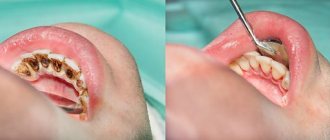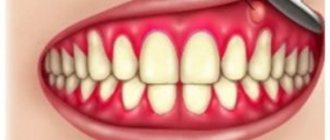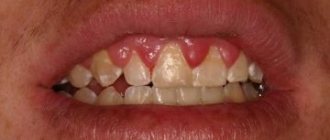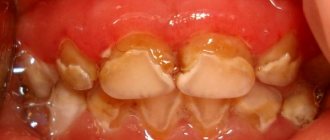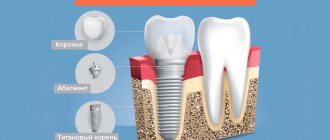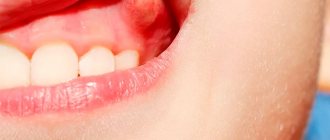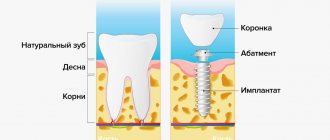- What is a gum former: photo
- What happens after a healing abutment is installed?
- Why does my gum hurt after inserting a gum former?
- The gum former fell out: what to do
- How long to wear
- Gum former: how long does it take to heal?
- How to place a gum former
- Possible complications
- Is it possible to do without a gum former?
- What manufacturers are there?
Dental implantation is one of the most modern and effective methods of orthopedic dentistry. It allows you to restore the integrity of the dentition, correct aesthetic defects and restore the functionality of the dental system. The essence of the procedure is to perform an operation with the installation of an implant, onto which a prosthesis is subsequently attached. Some patients still believe that implantation is an expensive service that is not available to many people. Nowadays it is possible to purchase all consumables at an affordable price; everyone can restore long-missing teeth and restore an attractive appearance to their smile.
Patients have many questions regarding the specifics of implantation, what stages it consists of, etc. An artificial tooth consists of several important elements; in addition to the titanium root, other products are involved in its formation. For example, a gum former device, little is known about it, but without it it is impossible to perform an operation. Today we decided to answer the most common questions about this product, why it is needed at all, what it looks like and what it consists of.
The absence of one or more teeth is a problem that every person can face. The patient almost immediately contacts the dentist for help when a defect occurs on the front part of the dentition, because he is noticeable to others, and he will no longer be able to simply smile. In the event that a molar is lost, which may not be visible, then treatment is postponed until later. Delay is fraught with serious consequences, which makes it difficult to carry out high-quality prosthetics.
The specialists of the A-medic clinic are often asked the following questions regarding the installation and care of the gum former. We answer the most popular and useful of them.
Gum former: what is it and why is it needed?
The gum abutment temporarily replaces the abutment that connects the root and crown. And at the same time prepares the space for completion of implantation - installation of the prosthesis. Many patients ask why a gum former is needed? Let's figure it out.
This construction is necessary to restore and maintain the contour of the gum tissue around the artificial tooth. As you know, after a tooth is removed, the gums and jawbone underneath stop receiving chewing load. Therefore, the tissues begin to atrophy. This process develops rapidly - in just 4-6 months, the gums seriously decrease in size - both in height and width. To restore the normal size of periodontal tissues, a gum former is used after implantation. As is already clear from the name of this element, it forms an even level or, one might say, a contour of the mucous membrane around the artificial crown. That is, so that the gums fit nicely, tightly, in a semicircle - exactly like on the adjacent living teeth.
New teeth in 1 day - All-ON-4 - 180,000 rub.
All inclusive!
3D modeling of the structure with a prosthesis, implantation of 4 Osstem implants, installation of a fixed prosthesis on the same day. Free consultation with an implantologist +7 (495) 215-52-31 or write to us
Bottom line
Implantation and prosthetics are a complex process that requires a highly qualified orthopedic dentist. With a long-term absence of a tooth, the bone tissue decreases in volume, and the gum tissue sags. For successful implantation, you need the correct gum contour, a formed socket for the artificial tooth and a sufficient amount of bone mass.
The healing abutment provides the necessary configuration for successful implantation. Externally, the temporary abutment is a thick screw with a cap that matches the size of the future artificial tooth crown. It is installed on a pre-implanted and osseointegrated artificial root of the future tooth.
After correcting the contour of the gingival margin, the temporary abutment is removed and a permanent structure is installed in its place.
Sources used:
- Robustova T. G.
Dental implantation: surgical aspects. - M.: Medicine, 2003. - Lee, S. L. (2007). Applications of orthodontic mini implants
. Hanover Park, IL: Quintessence Publishing Co, Inc. - Orthopedic treatment based on dental implants / Karl E. Misch. — M.: Reed Elsiver
What it looks like and what it is made of
Almost all patients are interested in what the gum former looks like and whether it will be visible when smiling or talking. The design is somewhat reminiscent of a solid screw with a thick cylindrical “hat”. Less commonly, its upper part is presented in the form of a truncated cone. The lower part looks like a threaded screw that is secured to the root of the implant. The crown part of the structure protrudes above the gum by only 1.5-2 mm, and does not fully replace the tooth. This is necessary so as not to put too much stress on the bone while chewing food while the implant takes root. After all, the main function of the structure is to form a sufficient amount of healthy gum tissue.
Shapers are made from titanium, or more precisely from an alloy of this metal. Titanium components are biologically inert - they do not reject, do not rust and do not release harmful substances into the human body. This metal is also very durable and, at the same time, very light.
Patients sometimes confuse formers with abutments. These are different designs, but in some ways their functions are similar. Shapers are a temporary measure and are installed on the chewing part of the row, i.e. they are not visible during a conversation or when a person smiles. Abutments are already a permanent element; they differ in shape and composition. An abutment serves to attach a crown (temporary or permanent) to an artificial root.
Materials for production
The healing abutment must withstand significant loads. That is why it is made only from durable materials. Often the structure is made of titanium, which differs in many respects from other metals and reduces the load on the root system of the oral cavity.
But it also has a number of disadvantages. Among them is the transmission of the structure through the gums. This spoils the appearance especially in cases where it is installed on the front teeth.
The former can also be made of zirconium. The material is resistant to external factors and, if installed correctly, can last a long time.
Less durable materials are plastic and ceramics. After a certain time of use, they require replacement, as they are not resistant to erosion. The choice of material from which the former will be made depends on many factors, for example, the individual characteristics of the patient and the subsequent stages of installation of artificial teeth.
Classification of gum formers
Modern technologies make it possible to produce several classes of structures - from budget to premium. All of them do an excellent job with their assigned function – restoring the correct shape of the gums. Differences occur in the quality of the material and the method of manufacture and processing. The majority of designs have universal sizes that are suitable for any patient. The most expensive ones are made individually for each specific patient. But, as a rule, this is not necessary at all - it is easier to perform plastic surgery on the mucous membrane.
In general, formers, like any other superstructures (components for an implant kit), should be installed from the same brand that you chose for dental implantation.
The main classes of shapers (just based on manufacturers):
- budget: Implantium, Alpha Bio - made in Korea and Israel,
- mid-price category: German, for example, XiVE,
- premium: Straumann, Nobel Biocare, Astra Tech - made in Switzerland, USA or Sweden.
For what types of implantation is it installed?
Let's figure out when a gum former is installed. Today, dental implantation is carried out using several methods:
- with delayed loading (classical method): first, a metal implant is screwed into the bone, after it has healed, the gum is incised and it is the turn of the gum former. It is installed for about a couple of weeks. However, in a number of situations, the implantologist fixes it almost immediately after implantation. As you can see, with this method, a shaper is definitely needed,
- with immediate loading of the implant: the entire process - from the introduction of an artificial root to the installation of a crown - takes a maximum of 7 days. Here, there is no need for a former, and it is not installed, because temporary abutments are immediately fixed, and a prosthesis is placed on top of them (this is if we are talking about the restoration of 1-2 teeth). That is, the abutment itself and the crown together with it can act as a former.
The construction is not installed during prosthetics on implants if the patient does not have all teeth or there is a large segment of missing ones. There is no need to change the shape of the gums, because... the prosthesis contains its plastic analogue - it is designed to hide the unevenness of the natural mucosa, at least at the first stage, when the implants take root. Afterwards, you can undergo plastic surgery and correct the position of the gums.
Risks for pregnant women
Pregnant women are considered a special group of patients. In some scenario developments, it may be impossible to do without a shaper, so this interesting situation has become a relative contraindication. Women are prohibited from performing microsurgery in the first and third trimester, but in the second trimester the procedure is quite possible.
Difficulties at this stage mostly come from taking concomitant medications. This is not just about medications for inducing anesthesia. Often painkillers and other conventional medications have restrictions specifically for pregnant women. But they are the ones you will need to relieve discomfort. Because of this, the doctor must give permission to carry out the manipulation, based on each specific case.
If during the initial examination it turns out that the situation is not critical and the problem is, rather, purely aesthetic inconvenience, then it is better to wait until the postpartum period.
Then it will be safe not only to insert the substitute, but also to carry out the second stage painlessly.
The average healing time for relatively healthy gums is about a week. But even taking this into account, the dentist must first make sure that the oral cavity is ready for prosthetics, and not rely only on numbers. Bleeding after surgery is also a normal phenomenon, which depends on the distinctive characteristics of the blood with its clotting parameters.
Stages of installation of the structure
Sometimes patients worry before the procedure, because not everyone understands how the gum former is placed during implantation, how long it will take and how painful it will be. You need to know that this is a surgical operation and it is performed only with the introduction of an anesthetic, i.e. without pain (the most painful thing that can happen here is the injection itself).
Let's consider the stages of installation of the structure:
- surgical opening of the gums over the implant: performed 2-6 months after its installation, depending on the quality of engraftment of the artificial root. By the way, engraftment lasts longer in older patients than in younger ones.
- cutting off excess tissue: so that the contour of the dentition is even,
- removing the plug: it sits in the artificial root and prevents soft tissue from growing into it,
- driver installation,
- suturing the tissue around the structure: to give the correct shape for the final implantation step.
As patients note, no pain is felt during the procedure. But when the anesthesia wears off - and this can happen after 2-4 hours (depending on individual susceptibility), painful sensations appear. But they are insignificant, because... There were no major incisions. They can last 1-3 days. During this period, the dentist usually prescribes painkillers, which should be taken as needed.
Patient's story: “I also encountered dental implantation, I had the top six done - I had problems with it for a long time, caries, pulpitis, in the end it was removed. But without a tooth, even if it is not visible, a woman is not comme il faut. They installed the implant and told me to come back in 2 months - then the doctor took a picture and said that it was time to shape the gum. It was scary! But it doesn't hurt at all. And this procedure took only 10 minutes according to my feelings. In the evening it hurt a lot, I took analgesics. Then it dragged on for 2 days and passed.”
How long does it take to heal and care for the structure?
After installing the component, the question arises: how long will it take for the gums to heal and how to wear the former correctly? After all, the patient wants to quickly get into the usual rhythm of life. In the absence of complications, wound healing and restoration of the gum contour occurs within 1-2 weeks. But sometimes the process can take a month.
The speed of healing depends not only on the individual characteristics of each person, but also on proper care. No matter how much the patient would like to complete the implantation as quickly as possible, he must carefully follow all the instructions prescribed by the dentist.
Post-procedure care includes:
- gentle brushing of teeth: you need to act very carefully so that the seams do not tear and the gums are not injured. A soft bristle brush is required
- oral baths: you can use Chlorhexidine, Miramistin or herbal infusions to relieve inflammation - whatever your implantologist prescribes. Intensive rinsing is excluded, because... the seams may be damaged,
- diet: food should be softened to reduce the chewing load (for faster healing). For a while, you should give up hard and dry foods, too hot or cold foods,
- decreased physical activity, no heavy lifting,
- antibiotics: prescribed to patients who are simultaneously restoring several teeth to reduce the risk of bacterial inflammation.
Anesthesia
If there is constant pain at the site where the former is installed, you need to do a gentle massage of the gums with tea tree essential oils, which help relieve pain.
A mixture of table salt (fine) and honey relieves pain well. For one part of salt, take 4 parts of liquid honey.
Baths made from infusion of calendula or echinacea flowers are good for pain relief. You should not rinse your mouth, but simply keep the liquid in your mouth and spit. The decoction should be used warm; you should not rinse your mouth with hot liquid - this will cause bleeding. A decoction of echinacea or calendula prevents the development of inflammatory processes.
Problems and complications after installation
Complications after the procedure can arise due to the characteristics of the body, improper care, or due to a poorly installed design. The patient may also notice that the gum former is loose. This sign indicates an incorrect installation. If you miss time, the structure may fall out of the “socket” and the metal implant will become overgrown with soft tissue. In this case, you must urgently contact the clinic so that the dentist can screw the component into place or install a new one.
The patient should be alert to the following symptoms (if they do not go away within 5-7 days): swelling, pain, bleeding, fever. If there are complications, the final stage of implantation is postponed until the tissue has completely healed. The implantologist will determine how long to wear the structure individually.
When can you get prosthetics?
The final stage of prosthetics occurs after complete healing of the gums around the former, i.e. in 1-4 weeks. The patient should not be bothered by pain, swelling or bleeding. If the tissue has recovered sufficiently, the final stage of implantation begins. At the preliminary appointment, the implantologist takes impressions of the jaws, which will help the specialist make a crown. The patient may also be referred for an orthopantomogram (OPTG) to see how the osseointegration of the metal implant is progressing. At the last stage, the former is unscrewed, an abutment is installed into the implant, and the final element is the crown.
Installation during pregnancy
Serious hormonal changes occur in the body of the expectant mother. Metabolism is being restructured, because Fetal nutrition is carried out at the expense of the resources of the mother's body. Against this background, the expectant mother’s immunity decreases, bones and teeth become more fragile. Therefore, dentists do not recommend dental implantation during pregnancy and lactation - so as not to burden the body and not harm the baby with medications.
However, a gum abutment is a more routine procedure. If you are faced with the fact that you had an implant installed before pregnancy and the need to fix the former fell just during this period, it is still worth postponing this stage until after the birth of the baby. After all, both the surgical intervention itself and the local anesthesia that is given during any treatment pose a rather great danger. In addition to the anesthetic, the injection may contain epinephrine (adrenaline), which is contraindicated for pregnant women. In exceptional cases, the installation of a former is allowed only in the second trimester of pregnancy and only with the permission of an obstetrician-gynecologist and dentist. But it is better to postpone this procedure until lactation is completed and the body is completely restored.
Author: Vasiliev A. A. (Thank you for your help in writing the article and the information provided)
Contraindications
It is prohibited to install the gum former when:
- Inflammatory lesions in the oral cavity;
- pregnancy;
- tuberculosis;
- cancerous tumors;
- type 1 diabetes;
- viral disease;
- high temperature.
Pregnant women are advised to wait to install metal pins because microsurgery is performed using anesthesia. Medicines can harm the fetus, even cause miscarriage.
Also, implants cannot be installed if there are anatomical defects in the jaw structure. In this case, preliminary plastic surgery to restore the maxillofacial region may be required. Only after this can the pin be implanted and the abutment installed.
